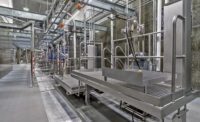This $650-million, nine-year remediation project is the world’s largest PCB cleanup in history. The massive project is dredging and processing 3.8 million cu yd of river sediment contaminated with polychlorinated biphenyls that can cause severe health problems for wildlife and for humans who eat fish from PCB-contaminated spots.

It will clean up 13.3 miles of the lower Fox River near Green Bay in northeastern Wisconsin.
The project’s newly constructed 250,000-sq-ft processing facility in Green Bay, Wis., houses equipment used to treat the PCB-contaminated sediment dredged out of the lower Fox River.
Owner: Tetra Tech Inc., Morris Plains, N.J.
General Contractor: Miron Construction Co. Inc., Neenah, Wis.
Design Firm: AECOM / Somerville Inc., Green Bay, Wis.
The facility houses eight of the world’s largest membrane filter presses and uses a one-of-a-kind processing system to separate and dewater the contaminated silt, which is ultimately placed in area landfills.
In the environment, PCBs attach themselves to organic compounds such as clay soil and wood. The process used at the Fox River Sediment Processing Facility removes the organic materials from the sediment, thereby removing the PCBs. The organics and PCBs are then landfilled. This process allows the non-organic sediments such as gravel and sand to be reused as capping materials in the river or as building materials on land.
The processing facility consists of a sand separation and dewatering building, a storage area for the dried-sediment filter cake; a treatment area for water removed from the sediment; and a support facility for engineers and other workers.
The high bay structural steel metal panel building was constructed with 22,000 cu yd of cast-in-place concrete and had to be completed within 13 weeks, a tight deadline for a project of this size and scope. A modular gang forming system allowed for the placement of 100-ft-long by 30-ft-tall concrete walls daily to maintain schedule on critical filter press support structures.
Pre-installation meetings between the owner, contractor, and subcontractors before every significant construction activity and equipment installation ensured that work was done correctly the first time.
Despite having up to seven cranes, four forklifts, 20 boom lifts, a fleet of miscellaneous equipment, and some 300 workers operating in close proximity, there were no lost-time accidents in the 360,000 man-hours needed to build the plant.
Miron Construction will assist with maintenance at the plant during the next nine years of river cleanup.


